
Root vegetable identification means knowing what a carrot is, what a yam is, and why it matters. This guide categorizes them by type (taproots, tubers, and rhizomes) and illustrates how to identify each one. We cover traits like size, skin texture, and interior color. Plus, you’ll learn handy ways to tell similar veggies apart. Let’s dive in now!
What are Root Vegetables?
In botanical terms, root vegetables refer to a broad group of edible underground plant structures. While commonly called “roots,” not all of them are true roots. Some are modified stems that have adapted to store energy, water, and nutrients, which are essential for the plant’s survival during periods of dormancy.
Root vegetables fall into two main categories:
| Type | Sub-Type | Definition / Features | Examples | Key Identification Clue |
| True Roots | Taproots | Single dominant root growing vertically, stores starch or sugar | Carrot, Parsnip, Beet, Turnip, Daikon | Tapered shape, central vascular core |
| Tuberous Roots | Swollen lateral roots for nutrient storage | Sweet potato, Cassava, Yam | Irregular shape, no “eyes,” nutrients in root cortex | |
| Modified Stems | Tubers | Swollen underground stems with “eyes” that sprout | Potato | Irregular and rounded, visible eyes (buds) |
| Rhizomes | Horizontal underground stems with nodes and internodes | Ginger, Turmeric, Lotus root | Segmented, branched with visible rings or nodes | |
| Corms | Solid, swollen vertical stems | Taro, Water chestnut | Smooth surface, solid inside, no rings | |
| Bulbs | Layers of modified leaves (scales) around a short stem | Onion, Garlic, Shallot | Layered structure, often papery skin |
Root Vegetable Types and Common Examples
Root vegetables come in many forms, some grow straight down into the soil, while others branch sideways or form swollen stems underground. Understanding these differences not only helps with root vegetable identification, but also gives insight into how they store energy and how best to cook or grow them.
Here’s a breakdown of root vegetable types by botanical structure, along with defining traits and common examples:
Taproots
Taproots are thick, central roots that grow vertically downward and act as the plant’s main anchor.
- Carrots – Recognized by their bright orange color and tapered shape, carrots are one of the most familiar taproots.
- Beets – Round with deep red or golden skin and flesh, beets often have striking concentric rings inside.
- Parsnips – Cream-colored and carrot-shaped, parsnips have a naturally sweet, nutty flavor that intensifies when roasted.
- Turnips – Typically white with purple tops, turnips have a slightly peppery taste and can be eaten raw or cooked.
- Daikon – A long, white Asian radish with a mild, crisp bite, commonly used in pickles and soups.
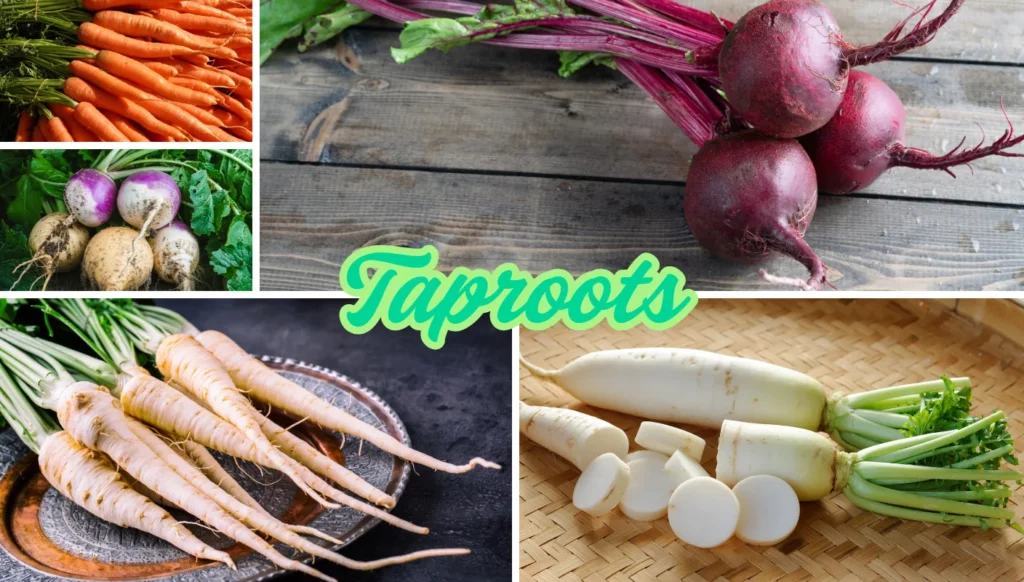
Tuberous Roots
These are swollen lateral roots that store starch but do not have buds or “eyes.”
- Sweet Potatoes – Smooth-skinned with vibrant orange flesh, they are soft and sweet when baked or steamed.
- Yams – Coarser in texture, with rough brown skin and white, purple, or reddish flesh depending on the variety.
- Cassava – A long, woody root with tough brown skin and starchy white interior; widely used for tapioca or flatbreads.
- Ube – A vivid purple yam used in many Filipino desserts; its rich color makes it easy for root vegetable identification.
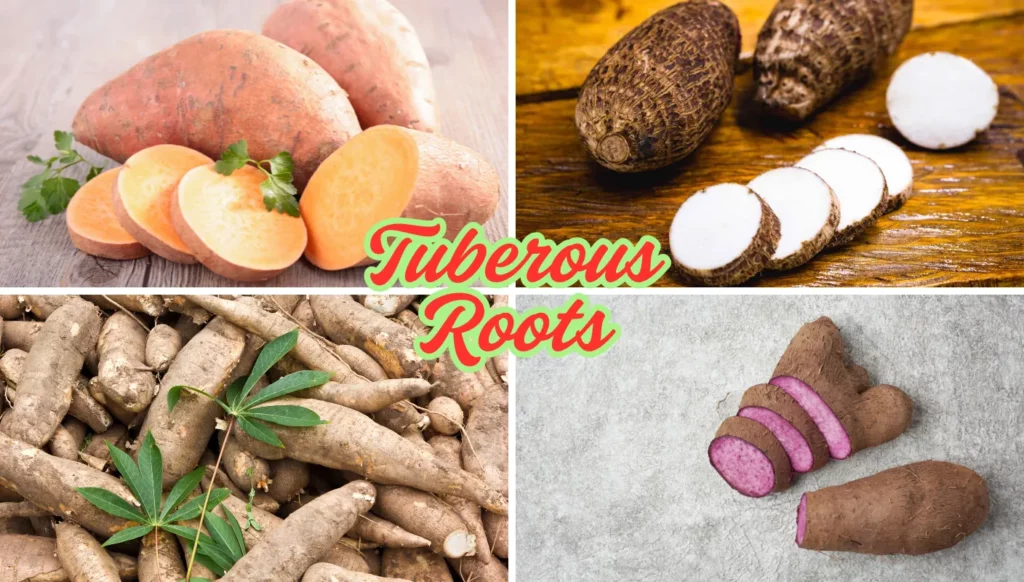
Tubers (Modified Stems)
Tubers are underground stem parts that swell to store energy and have visible “eyes” that can sprout.
- Potatoes – Found in countless varieties with different skin and flesh colors; easily identified by their buds.
- Jerusalem Artichokes – Also called sunchokes, these tan, knobby tubers have a nutty flavor and crisp texture.
- Jicama – A crunchy, slightly sweet root with pale brown skin and white flesh; often eaten raw in salads.
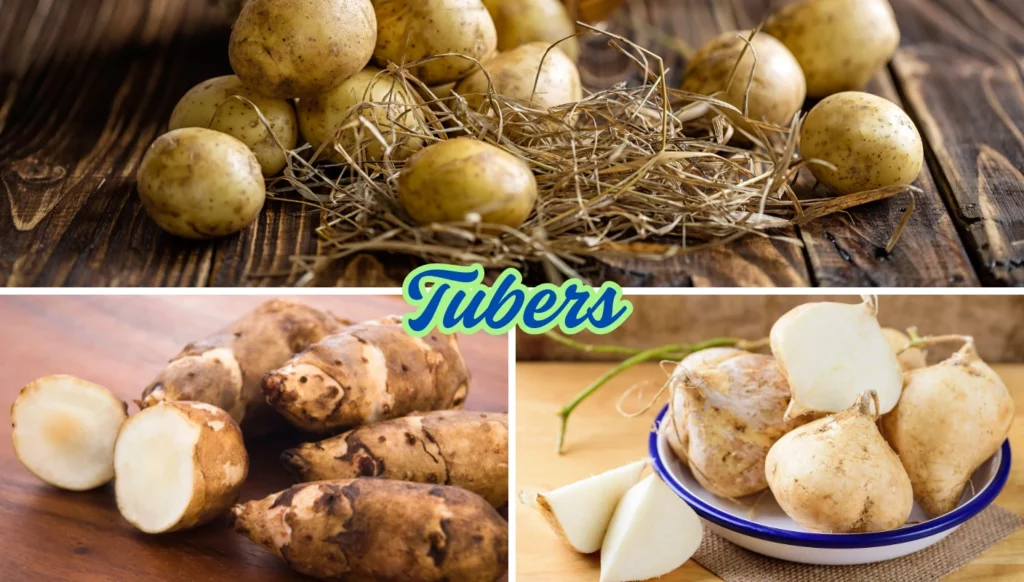
Rhizomes
Rhizomes grow horizontally beneath the soil, storing nutrients and generating new shoots.
- Ginger – Known for its pungent, aromatic taste, ginger has a light brown skin and pale yellow, branched interior.
- Turmeric – Similar to ginger but with orange flesh and a warm, earthy flavor; used in both cooking and traditional medicine.
- Lotus Root – A long, tubular rhizome with a distinct “wheel-like” pattern inside, commonly used in Asian dishes.
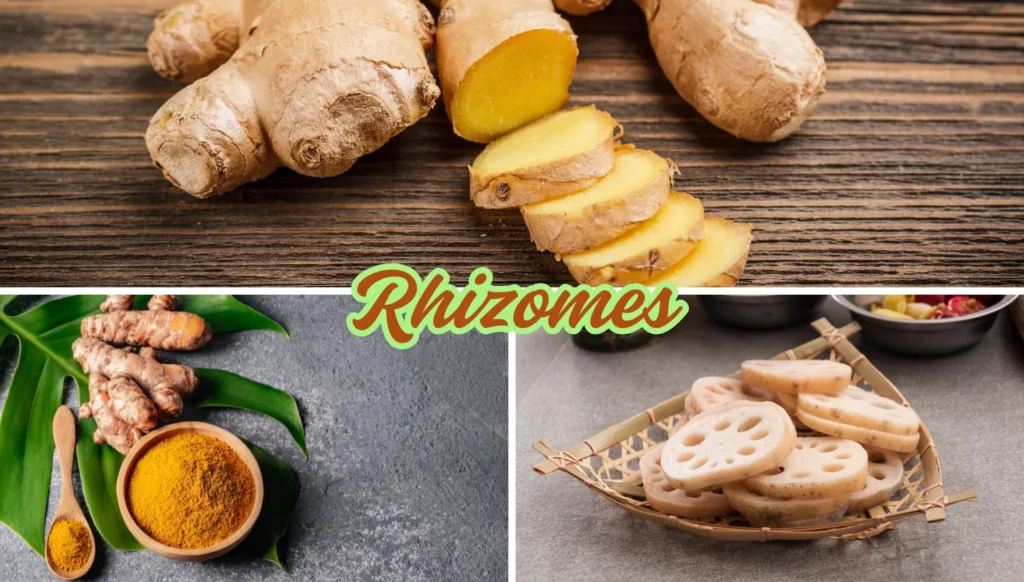
Corms
Corms are short, rounded underground stems that are solid inside, unlike bulbs.
- Taro – Has hairy brown skin and creamy white or purple-speckled flesh; a staple in tropical cuisines.
- Water Chestnuts – Small, round, and crisp, these are eaten raw or cooked, often found in stir-fries.
Bulbs
Bulbs are made of layered leaves surrounding a short stem base. They store nutrients to help the plant regrow.
- Onion – Comes in red, yellow, and white varieties, with concentric rings and a pungent aroma.
- Garlic – Forms in cloves, each wrapped in papery skin; strong and spicy when raw, mellow when roasted.
- Shallots – Smaller than onions with a milder flavor, often used in sauces or salad dressings.

How to Visually Identify Root Vegetables?
Accurate root vegetable identification relies heavily on external and internal visual features. Because most root vegetables develop underground, their appearance reflects specific biological functions, including nutrient storage, environmental adaptation, and vegetative reproduction. Below are four key visual criteria used in botany and horticulture to distinguish root types.
Shape and Size
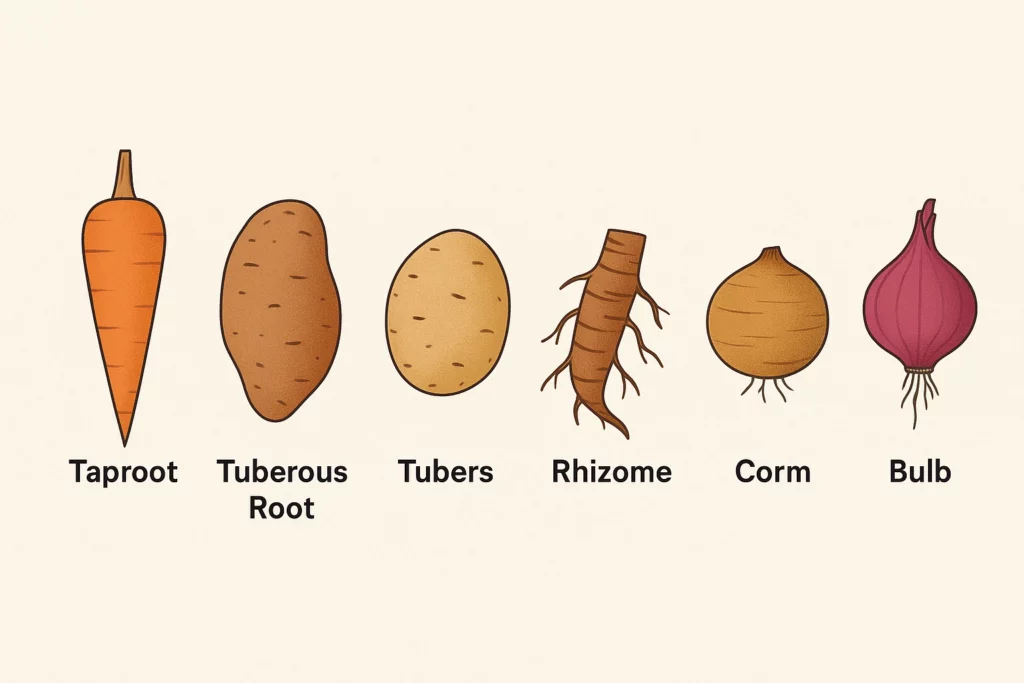
Root structure is closely linked to plant function. Taproots typically exhibit a conical or fusiform shape, being thicker at the top and tapering downward, which allows for deep anchorage and efficient vertical growth. Tuberous roots, in contrast, are often elliptical to irregular in shape, with no dominant axis, reflecting lateral development and starch accumulation.
Modified stems vary further:
- Tubers tend to be globular or ovoid and may display irregular swelling due to meristematic growth.
- Rhizomes are cylindrical and segmented, growing horizontally.
- Corms are round to oval, compact, and vertically oriented.
- Bulbs appear spherical to teardrop-shaped, due to concentric leaf bases.
Skin and Flesh Color
Color variation serves both physiological and taxonomic purposes. For example, high anthocyanin concentrations yield deep purples or reds, while carotenoids produce oranges and yellows. Root cortex and vascular cambium layers often differ in pigment, especially in storage roots. Skin coloration may indicate species, maturity, or cultivar:
- Pale or white roots often signal low pigment and mild flavor.
- Intense pigmentation often correlates with the presence of antioxidants.
- Subsurface color gradients may suggest cultivar type (e.g., white core with red rings).
In field practice, slicing a sample is often required for conclusive root vegetable identification.
Surface Texture and Morphology
Texture provides tactile indicators of botanical type:
- Smooth surfaces imply uninterrupted epidermal growth, which is common in cultivated taproots and commercial tubers.
- Knobby, branched surfaces often indicate rhizomatous or fibrous root systems, where secondary growth or adventitious roots emerge irregularly.
- Hairy or rootlet-covered textures suggest ongoing absorption or fibrous root structure, especially in early developmental stages.
Epidermal thickness also varies: tubers often have thicker skin (periderm), while bulbs and true roots typically have thinner, more delicate coverings.
Cross-Sectional Patterns
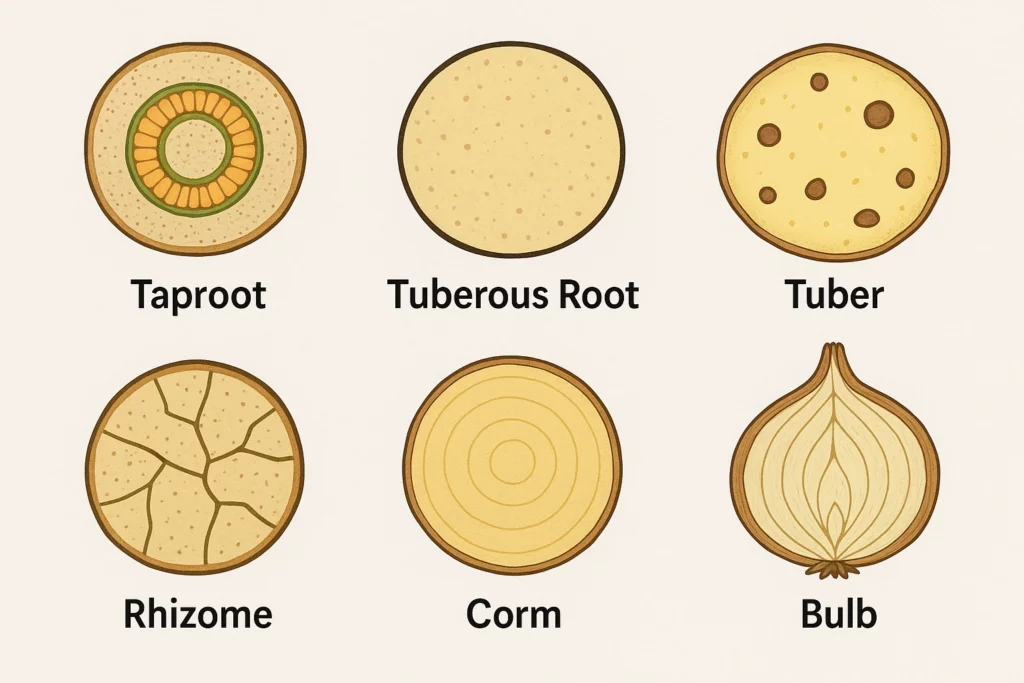
Cut surfaces offer diagnostic features for internal structure:
- Taproots exhibit a central xylem core surrounded by phloem, forming concentric vascular rings.
- Tuberous roots lack internal buds and display uniform parenchyma with less vascular differentiation.
- Tubers reveal scattered vascular bundles and visible buds (“eyes”).
- Rhizomes display nodes, internodes, and branching points across the cross-section.
- Corms are solid inside, with growth rings sometimes visible depending on age.
- Bulbs exhibit concentric layers of fleshy modified leaves around a central bud.
These anatomical markers are foundational to plant identification and classification, especially when vegetative parts above ground are absent.
Using Leaves, Stems, and Growth Clues for Root Vegetable ID
These clues are invaluable when roots look similar, or when only part of the plant is visible.
Leaf Shape and Growth Habit
Different root vegetables support various types of leaves. Plants that produce deep, single taproots often grow upright, finely divided leaves. Meanwhile, vegetables with broader or rounder roots typically develop wider leaves, sometimes forming a low-growing rosette close to the soil.
While leaf color and texture vary, you can look for:
- Narrow, lacy leaves (common in plants with long, pointed roots)
- Broad, slightly hairy leaves (often paired with bulbous or rounded roots)
- Visible leaf veins or colored stems, which sometimes match the root’s interior
Recognizing these patterns builds your accuracy in root vegetable identification, especially when assessing seedlings or immature plants.
Stem Structure and Bud Features
Now shift your focus to where the plant connects to the soil. The stem’s size, structure, and any visible buds can tell you whether you’re looking at a true root or a modified stem.
- A thick stem often supports a large storage organ. This might indicate a tuber, corm, or bulb.
- If you see small bumps or “eyes”, that’s a giveaway: the plant stores energy in stem tissue, not root tissue. These buds can sprout, making tubers easy to identify.
- Horizontal stems with node scars or branching rings signal a rhizome, not a typical root.
These stem-based features are key to distinguishing between underground parts that look alike but have very different structures and growth patterns — a central idea in proper root vegetable identification.
Signs of Freshness
Once you’ve identified the type, you still want to know whether it’s in good condition. Surface clues tell you a lot about freshness and how long it’s been out of the ground.
- Firmness: The root should feel dense, not rubbery or shriveled
- Color: Vibrant flesh and skin tones suggest a recent harvest
- Greens: If still attached, fresh leaves should stand upright and look crisp
Common Root Vegetable Lookalikes: Quick Comparison
| Pair | How They’re Different | Key Visual Cues |
| Sweet Potato vs. Yam | – Sweet potato: smooth skin, moist orange flesh – Yam: rough, bark-like skin; dry, starchy white or purple flesh | – Flesh color (orange vs. white/purple) – Skin texture (smooth vs. coarse) |
| Ginger vs. Turmeric | – Ginger: pale yellow flesh; spicy, citrusy aroma – Turmeric: deep orange flesh; warm, earthy scent | – Cross-section color – Strong, distinct smell when cut |
| Beets vs. Radishes | – Beets: dense, sweet flesh; often deep red or golden – Radishes: lighter, crisp texture; sharp, peppery taste | – Shape (round vs. tapered) – Flesh density and flavor |
| True Roots vs. Modified Stems | – True roots: no buds or nodes; uniform internal tissue – Modified stems (e.g., tubers): have eyes, nodes, or rings | – Presence of buds or scars – Growth pattern (vertical vs. horizontal) |
Final Thoughts
Root vegetable identification can feel tricky at first, but with a bit of practice, it becomes second nature. Ultimately, the clues are readily apparent in the leaves, stems, and cross-sections. For extra support, the Planteyes app can help you ID unfamiliar roots in just a few taps.
FAQs
Which root vegetables grow best in containers?
Shallow to medium-depth root vegetables, such as radishes, carrots (short varieties), beets, and turnips, adapt well to containers. Ensure the pot is deep enough to accommodate root expansion and has good drainage.
Are all root vegetables edible raw?
No. Some root vegetables, such as carrots, radishes, and jicama, are commonly eaten raw. Others, like cassava or taro, contain natural toxins and must be cooked to be safe. When in doubt, check the preparation requirements first.
Is there an app that helps identify root vegetables by photo?
Yes. Apps like Planteyes allow you to snap a photo of the plant or harvested root and get instant ID help. They’re especially useful for gardeners or market shoppers unsure of unfamiliar varieties.
What are the best root vegetables to eat?
That depends on your taste and how you plan to cook them. Nutrient-rich and versatile options include carrots, beets, sweet potatoes, parsnips, and turnips. They offer a range of flavors, from sweet to earthy to peppery, and work well roasted, mashed, or raw.
How do I store root vegetables after harvest?
Step 1: Brush off excess soil without washing.
Step 2: Trim greens to about 1 inch.
Step 3: Sort and remove any damaged roots.
Step 4: Store in a cool, dark, ventilated place.
Step 5: Use sand, sawdust, or crates to maintain humidity.
Step 6: Check regularly and remove any spoiled ones.


